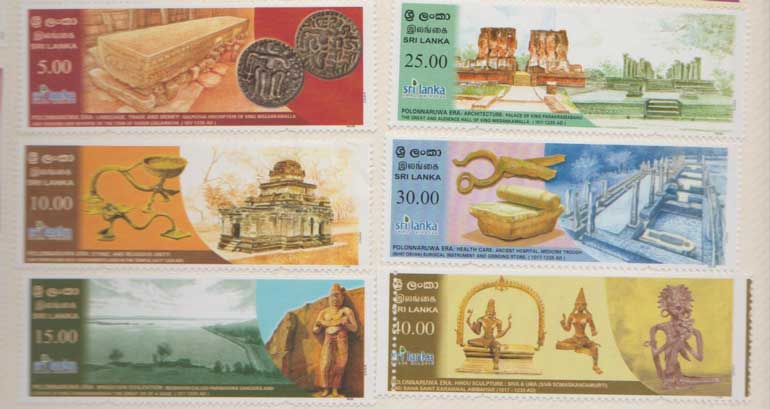Friday Dec 26, 2025
Friday Dec 26, 2025
Saturday, 23 April 2016 00:00 - - {{hitsCtrl.values.hits}}
 Following numerous invasions from time to time and aided by internal conflicts, in 993 CE the Cola army from South India captured Anuradhapura, set the city on fire, looted everything and grabbed all the treasures. That was the end of the Anuradhapura kingdom after a continuous period dating back to the second century BC.
Following numerous invasions from time to time and aided by internal conflicts, in 993 CE the Cola army from South India captured Anuradhapura, set the city on fire, looted everything and grabbed all the treasures. That was the end of the Anuradhapura kingdom after a continuous period dating back to the second century BC.
The Colas shifted the capital to Polonnaruwa and their rule lasted 77 years before Vijayabahu, a prince from Ruhuna, marched to Anuradhapura and entered the former capital challenging the Colas. In 1070 he stood victorious at Anuradhapura at the age of 33 and the 15th year of his accession as ruler of Ruhuna in South Sri Lanka.
Victorious Vijayabahu
“At long last, after a childhood of travail and 17 years of warfare against greatly superior forces, during which his will to conquer never weakened despite bitter defeats and disappointments, treachery and revolt, Vijayabahu stood victorious at Anuradhapura at the age of 33 and in the 15th year since his accession as ruler of Ruhuna,” writes historian C.W. Nicholas in ‘A Concise History of Ceylon’ (1961).
After the first couple of years in Anuradhapura, Vijayabahu transferred the capital to Polonnaruwa, which was a place of strategic importance. It commanded the crossings of the Mahaweli Ganga, the defence of which was vital against rebel forces advancing into Rajarata from Ruhuna.
In the event of an invasion by a South Indian power, its position was distant enough to give time for the organisation and manning of the river defences so as to halt the invading forces on the river-line. Also in case those defences failed, a retreat to Ruhuna was possible.
Hindu influence
Hindu influence is clearly visible as a result of the Cola rule. The Shiva Devale featured in the Rs. 10 stamp is one of the oldest buildings in Polonnaruwa. It has been built entirely of rock stone according to South Indian architecture. An inscription in the Devale premises mentions its name as “Wanawanamadevi Ishwara Mudeyar’ after the name of the consort of the first Cola king, Raja Raja Cola. Shiva ‘linga’ is displayed in the Devale.
Materials used for ‘poojas’ in the Devale unearthed during excavations can be seen on the left.
Hindu sculptures are featured in the Rs. 40 stamp. In the left corner is the ‘Somaskanda Murti’ where God Shiva is seen seated on his seat with one leg on it and the other put down. Of his four hands, he holds a hand axe (‘keteriya’) with one of his right hands and an image of an animal with one of the left hands. Two symbols are in the other two. The space left in the seat is apparently for goddess Uma. Both form the ‘Somaskanda Murti’.
In the middle is God Skanda as he sits in his seat which is the peacock.
The sculpture on the right is a rare one of a weird female found in the Shiva Devale.
Parakramabahu the Great
The death of Vijayabahu, hailed as a warrior who could not be surpassed by any other Sinhalese king, at the age of 73 in 1110/11 was followed by intrigue and dissension until Parakramabahu I (1153-86) became king.
According to the Mahavamsa, the Great Chronicle, Parakramabahu put into effective practice four kingly aspirations: the happiness of people; the stability of the religion; the [protection of the nobility; and the support of those in want. He made Polonnaruwa a typical royal city with palaces, monasteries, parks and ponds. Providing irrigation facilities in the whole island was one of his priorities. According to the Culavamsa, he constructed or restored 165 dams, 3910 canals, 163 major tanks and 2376 minor tanks.
The R 15 stamp features the Parakrama Samudra built by him covering an area of 5,940 acres irrigating 18,200 acres. Many regard the rock statue on the right is that of the king.
The palace seen in the Rs. 25 stamp (left) is that built by him. The huge palace, of which only the remains are now seen, was called ‘Vijayothpaya’ – a name used in the heavens – indicating its grandeur. On the right is the Audience Hall of King Nissanka Malla (1187-96) where the royal court sat, located close to the Parakrama Samudra. The lion throne used by the king can be seen inside. Names of the members of the royal court are mentioned in short inscriptions on the stone pillars inside the hall indicating where they should sit.
The hospital built by King Parakramabahu in the Alahena Pirivena complex is featured in the Rs. 30 stamp. Alongside are two implements used in the hospital – one is a surgical instrument (quite similar to ones used today) and the other a grinding stone used to grind medicinal herbs. Note how each ‘kuti’ (monk’s abode) had been provided with a medicinal stone bath in the spacious courtyard.
In the Rs. 5 stamp is the ‘gal potha’ which is 25 feet 10 inches long and four feet seven inches wide with designs carved out of rock. A creation of King Nissanka Malla, It carries an inscription about him and his heritage detailing his right to the throne.
On the right is a coin which belongs to the time of Queen Lilavati (she ruled thrice between 1197 and 1212). It carries the legend ‘Sri Raja Lilavati’.